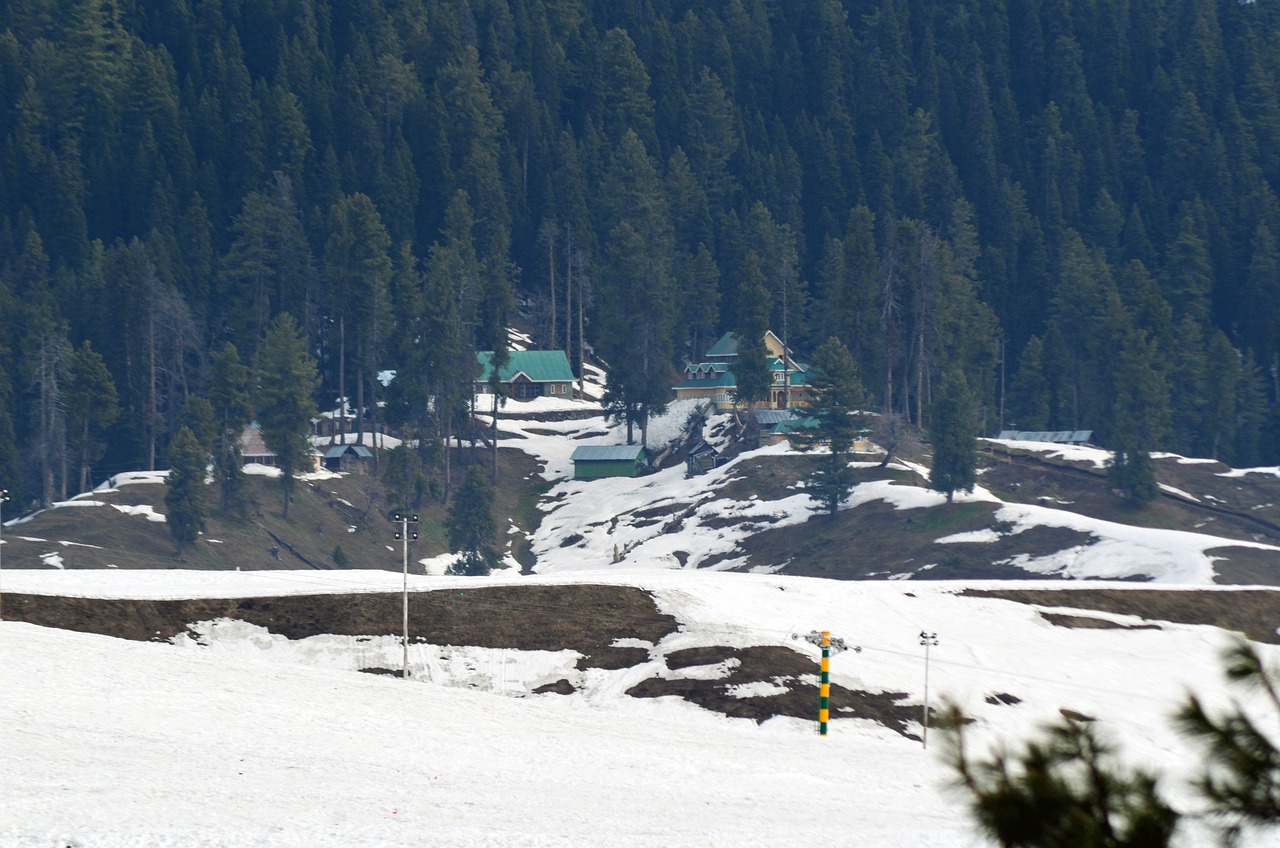|
Getting your Trinity Audio player ready...
|
Immersed in a unique concoction of breathtaking natural beauty and idiosyncratic climatic characteristics, Kashmir stands as a region whose weather is as fascinating as it is complex. Nestled in the Himalayan region, Kashmir, known as heaven on Earth, experiences a range of weather patterns that are fueled by its distinct geographical position. Weather, serving as an elemental factor, greatly influences the everyday life, agriculture, tourism, and overall economy of the region. This exploration delves into the weather dynamics of Kashmir, unraveling the diverse seasonal variations and the impacts they exert on regional life and economy.
Understanding Kashmir’s Geographical Position
Geographical Positioning of Kashmir: At the Intersection of Climate Extremes
Kashmir, a northeastern region in the Indian subcontinent, is strategically located in the Himalayan region, which influences the area’s exceptional weather patterns and climatic features. The geographical positioning results in a frigid climate in winter and moderate temperatures in summer, underscoring the reason behind the distinctly seasonal weather observed in this region.
Effect of Himalayan Mountains on Kashmir’s Weather
The Himalayan mountain range, which stands as a barrier to the cold winds blowing from Central Asia, largely shapes the weather of Kashmir. In the winters, sub-zero temperatures are common, while the summer months experience milder temperatures. The physical extension of Kashmir in the plains of Punjab at the bottom and high altitudes of the Himalayas at the top contributes to the formation of this unique semi-arctic climate.
The Unique Microclimate of Kashmir
This significant positioning also endows Kashmir with a unique microclimate resulting in diverse weather conditions across the region. The northernmost areas of the region closest to the Himalayas are stark and arid, experiencing much colder temperatures throughout the year. The southern regions, nestled in the foothills of the Himalayas, are warmer and witness a significant amount of rainfall.
Climate Features and Seasonal Variations in Kashmir
Kashmir has four clear-cut seasons, each with its unique charm: winter (December–February), spring (March–early May), summer (early May–August), and autumn (September–November). In winter, the region remains snowbound due to cold waves, which often pass through the northwest Himalayan region and result in extreme cold conditions. Spring, the season of blossoms, is moderate, while summer is characterized by a pleasant temperature between 20°C to 30°C. Autumn is considered the season of fallen leaves and a bare landscape.
Implications of Geographical Positioning on Kashmir’s Weather Forecasting
Due to the geographical position and topography of the region, accurate weather forecasting in Kashmir is a challenging task. Forecasts have to take into considerations the unique geographical location of the region, the local terrain and widespread microclimates, and the impact of the mighty Himalayan range.
In the shadows of the Himalayas, the area known as Kashmir basks in a dynamic and diverse climate unlike any other in the India subcontinent. The region’s position and vast geographical diversity result in a wide variety of weather conditions and microclimates, making weather forecasting a challenging endeavor.

Seasonal Weather of Kashmir
Embrace the Reblossoming of Kashmir in Spring
As the calendar flips to March and stretches out until early May, Kashmir welcomes spring, a season draped in lush colors and picturesque natural beauty. During this sunny period, temperatures typically hover around a comfortable 59 to 70°F, fostered by gentle breezes that carry the fragrance of blooming apples. Rainfall in this phase is minimal, generally light showers, making it an ideal time for sightseeing and exploring the splendors of the valley.
Kashmir Summer Weather: A Retreat from the Heat
Summer ascends over Kashmir from May to August, providing a much-needed retreat for locals and tourists from the relentless heat of other parts of India. The temperature usually fluctuates between 20°C to 30°C (68 to 86°F) with the days being pleasantly warm while the nights are fairly cool. Rainfall is moderate during summer as short, swift showers help in maintaining the pleasant atmosphere.
Kashmir’s Autumn Season: Colors Alive
Autumn steps onto the stage from September to November, transforming the Kashmir valley into a palette of golden hues. The climate during autumn is mildly warm with temperature variating in the range of 10°C to 20°C (50 to 68°F). The region experiences minimal rain, and the weather remains mostly dry, offering beautiful, clear blue skies that perfectly backdrop the changing colors of the landscape.
Kashmir Winter Weather: Land of Snow
Winter in Kashmir truly paints a picture of a winter wonderland. Occurring from December to February, temperatures can plummet below freezing, making it very cold. The region records heavy snowfall with an average of 60-85 cm, particularly in the areas of Gulmarg and Sonamarg. The temperature during the day hovers around 0°C to 15°C (32 to 59°F) while nights can drop as low as -8°C (17.6°F). Despite the intense cold, it lures travelers who enjoy winter sports like skiing and snowboarding.
The climate of Kashmir is distinguished by its diverse seasonal variations, each offering a unique ambiance and experience. From the vibrant bloom of spring and the pleasant warmth of summer to the riot of colors in autumn and the frosty beauty of winter, Kashmir provides a host of weather conditions and attractions for every guest. As such, your packing list should coincide with the season during which you intend to visit. You’ll need warm apparel during the winter season and preferably lighter, breathable clothes for spring and summer.

Understanding Weather Patterns in Kashmir
Deciphering Kashmir’s Weather Patterns
Located in the northern region of India, Kashmir’s climate mirrors its varied geographical features. This area of mountainous terrain experiences unique shifts in temperature and rainfall at different times of the year. Differences in weather conditions are especially notable among the three zones of Kashmir – Jammu, Srinagar, and Ladakh.
Modeled on a Mediterranean climate, Kashmir’s weather patterns are fairly consistent, transitioning with the changing seasons. December to February marks the winter season, characterized by temperatures plunging below freezing point coupled with intense snowfalls. From March to May, you can experience spring with a landscape teeming with blooming flowers, clear blue skies, and moderate temperatures. June to August defines the summer season which is quite mild here, registering mean temperatures of around 20 to 30 Celsius. The autumn season, lasting from September till November, promises enjoyable weather and breathtaking views of multicolored falling leaves.
The weather in Kashmir significantly affects the region’s lifestyle and day-to-day activities. The harsh winter cold can meddle with routine life and occasionally isolate parts of the region due to heavy snow. Conversely, the agreeable days of spring and summer provide excellent conditions for agricultural work and tourism-related activities. Thus, it’s no surprise that the area records a spike in tourist traffic during these favorable weather seasons.
Historical Weather Conditions in Kashmir
Historically, Kashmir’s weather patterns had been predictable and stabilizing, a phenomenon that has, however, been significantly disrupted by climate change. For instance, there has been an observable increase in the frequencies of extreme weather events, such as heavy snowfall and rainfall, causing flash floods and avalanche threats. The valley has also experienced increasingly warmer summers.
Impact of Climate Change on Kashmir’s Weather
Recent studies have shown a significant impact of climate change on the weather patterns in Kashmir. Rising temperatures have been reported, contributing to the melting of glaciers at a faster pace, which is worrisome. The rising temperature trend is also affecting the region’s overall biodiversity and disrupting the traditional agricultural practices of the local residents.
Furthermore, the uncertainties associated with changing weather patterns pose immense challenges for the tourism sector. The increasingly unpredictable snowfall patterns can hamper winter tourism in the region. The unpredictability in the monsoon and its deviation from the usual trend disturbs the planning of agricultural activities and can potentially affect the overall productivity, thereby impacting the socio-economic conditions of the populace.
The weather patterns in the breathtaking region of Kashmir hold notable influence over numerous sectors, including climate change mitigation and adaptation, as well as tourism. It’s particularly beneficial for travelers to have a grasp of these weather patterns to efficiently schedule their trips during optimal conditions. This ensures they are able to fully relish in Kashmir’s natural charm.

Kashmir Weather Forecasting: Methods and Application
The Science Behind Kashmir’s Weather Forecasting: A Practical Application
Kashmir, known for its diverse topography in the northern part of the Indian subcontinent, goes through a varied array of weather conditions. To understand and predict these changing patterns, the region employs advanced scientific methodologies and tools for weather forecasting.
Key participants in this process are meteorologists who leverage scientific technology and established principles to gauge future atmospheric conditions. They use weather radars, satellites, and computer models for data collection and analysis. Essential metrics such as temperature, humidity, wind speed and direction, and atmospheric pressure are collected from multiple monitoring stations spread across the Kashmir region.
Despite significant improvements in recent years, forecasting accuracy isn’t perfect. Sudden shifts in wind patterns, the terrain’s variability, and changing seasons can all impact the accuracy of weather predictions. Meteorologists are constantly refining these forecast models based on historical data, current trends, and prospective predictions, all in a bid to improve forecast accuracy.
Beyond the science of it, weather forecasts serve a practical purpose across numerous sectors in Kashmir. The agricultural sector, for example, is reliant on these predictions. Farmers use accurate weather forecasts for essential farming activities like crop planting, irrigation, and protection against diseases and pests. Hence, accurate weather forecasting is integral to ensuring food security and offering a livelihood to the region’s farming population.
For the tourism industry and visitors, weather forecast is a guiding force for planning. Tourists can plan their travel based on the predicted weather conditions, and service providers can anticipate peak seasons. Moreover, precise weather forecasts hold importance for local events and open-air festivals whose success largely depends on appropriate weather conditions.
Additionally, these forecasts play a pivotal role in disaster management. Early warning about extreme weather events like heavy snowfall, flash floods, and landslides could potentially save lives and mitigate damage. Such forecasts allow local government bodies and disaster management entities to plan evacuation strategies, emergency responses, and relief operations more effectively.
In a nutshell, weather forecasting holds a crucial position in Kashmir’s overall functioning. It utilizes advanced science and technology and is integral to sectors like agriculture, tourism, and disaster management. Though its accuracy might vary at times, continuous technological advancements and methodological improvements assure progressively precise forecasts.

The Impact of Weather on Kashmir’s Economy
The Weather’s Role in Kashmir’s Agriculture
Kashmir’s economy heavily depends on its agricultural sector, which makes significant contributions to the region’s GDP and employment opportunities. This sector, however, is extremely weather-dependent. The region primarily cultivates rice, which grows well in warm, humid climates, and apples, which prefer cold weather. This means that the area’s agriculture is highly impacted by seasonal changes and weather extremes.
Throughout the year, Kashmir’s valleys receive plentiful rainfall, aiding in crop growth. However, during the monsoon season from June to September, devastating floods can occur. These floods cause severe soil erosion and effectively wipe out entire crops.
Looking at the cold, snowy winters in a different light, they prove beneficial for apple orchards as apple trees need cold weather to break dormancy and bear high-quality fruits. But, out-of-season snowfall and prolonged cold can also hurt the apple crop, leading to significant economic losses.
Impact of Weather on Tourism in Kashmir
Tourism is another key economic sector in Kashmir, with the region’s picturesque landscapes and pleasant summer weather attracting tourists from across the globe. The geography of Kashmir allows it to provide a sense of relief to mainland Indians from the scorching summer heat, consequently, the temperature oscillation between the mainland and Kashmir encourages tourism in the region.
However, the local tourism industry also bears the brunt of the weather volatility. Excessive snowfall during winter results in blocked routes and disruption of transportation services, leading to a decline in tourist visits. Excessive rainfall during the monsoon can also cause floods and landslides, posing a risk to tourist safety and hampering tourism activities.
The Role of Weather Forecast in Economic Decision Making
Accurate weather forecasting is critical to mitigate the impact of extreme weather conditions on the economy of Kashmir. For instance, timely weather predictions can help farmers plan their planting or harvesting schedule, reducing the risk of crop failure. Similarly, the tourism industry can use these forecasts to plan their promotional campaigns or make necessary safety arrangements.
Efficient weather forecast systems can also aid government agencies in preparing for natural disasters, helping to minimize economic losses. By providing an early warning for floods or heavy snowfall, they can implement measures like evacuation, distribution of relief materials, or mobilizing recovery processes, thereby reducing the overall impact on the economy. Importance of weather knowledge thus cannot be overstressed for the economic sustenance of the region.

Unraveling the web of Kashmir’s intricate weather patterns not only enhances our understanding of this unique region, but it also underscores the importance of accurate weather forecasting. The region’s economy, predominantly sustained by industries like agriculture and tourism, gravely depends on these forecasts. A comprehensive understanding of weather patterns in Kashmir and the application of accurate forecasting can catalyze prudent economic decision-making processes and contribute to more strategic agricultural practices, effective disaster management, and a more prosperous tourism industry. By comprehending Kashmir’s weather idiosyncrasies, we can appreciate and adapt to the nuances of life in this heavenly region.
Writio: The AI writer revolutionizing content creation This article was written by Writio.












